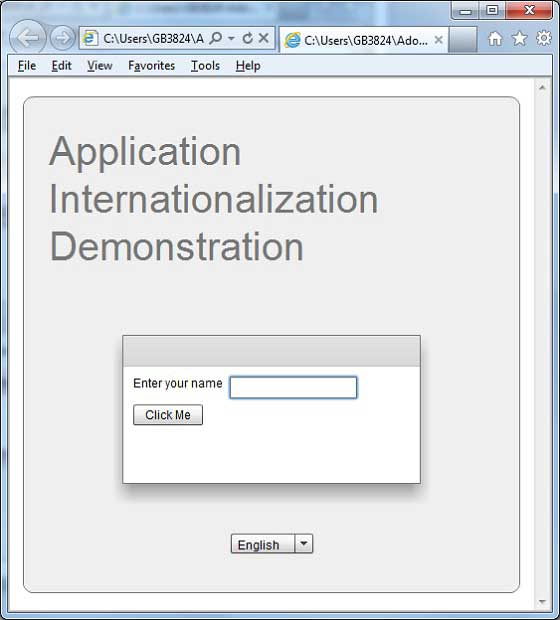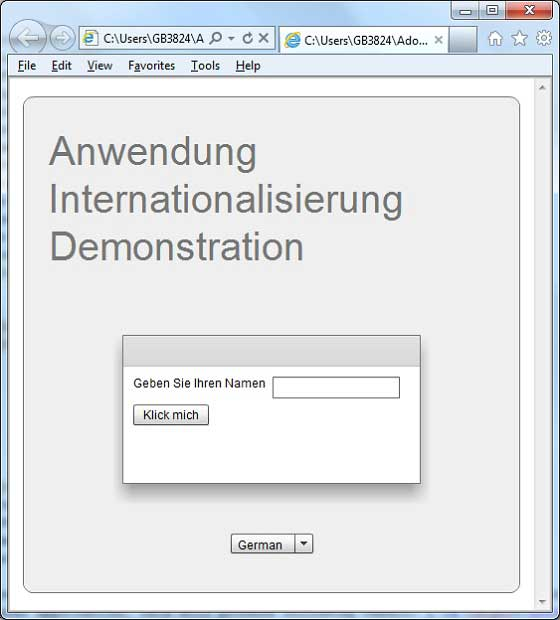Flex Internationalization
May 25, 2021 Flex
Table of contents
1. The workflow that internationalizes Flex applications
2. Step 1: Create a folder structure
3. Step 2: Create a property file
| Technology | Describe |
|---|---|
| The compilation time is internationalized | This technique is the most common and requires very little overhead at runtime; /b10> Is a very effective technique for translating constant and paramethy strings; T he simplest implementation. /b11> Compile-time internationalization uses standard property files to store translated strings and paramethy messages that are compiled directly in the application. |
| Run-time internationalization | This technique is very flexible, but slower than static string internationalization. /b10> You need to compile the localized property files separately, keep them outside the application, and load them at runtime. |
The workflow that internationalizes Flex applications
Step 1: Create a folder structure
Create a locale folder under the src folder of the Flex project. T his will be the parent directory of all property files for the locale that the application will support. /b10> In the locale folder, create a sub-folder, and support one for each application's locale. The convention for naming a language environment is
{language}_{country code}
For example, en_US represents English in the United States. /b10> The locale de_DE german. The sample application will support two common languages: English and German
Step 2: Create a property file
Create a property file that contains the messages you want to use in your application. /b10> We created a HelloWorldMessages.en_US file under the src and locale and locale files.
enterName=Enter your name
clickMe=Click Me
applicationTitle=Application Internationalization Demonstration
greeting=Hello {0}
Create a property file that contains translation values that are specific to the locale. /b10> We created a HelloWorldMessages.de_DE file under the src and locale and locale files. /b12> This file contains translations in German. /b13> _de to specify a German locale, we will support German in our application.
If you want to create a property file using Flash Builder, change the encoding of the file to UTC-8. S elect the file, and then right-click to open its property window. S elect the text file to encode as a different UTF-8. Apply and save the changes.
enterName=Geben Sie Ihren Namen
clickMe=Klick mich
applicationTitle=Anwendung Internationalisierung Demonstration
greeting=Hallo {0}
Step 3: Specify the compiler options
-
Right-click the item and select the property.
-
Select the Flex compiler and add the following to the Other Compiler Parameters settings:
-locale en_US de_DE
-
Right-click the item and select the property.
-
Select the Flex build path, and then add the following to the source path settings:
src\locale\{locale}
An example of internalization
Now let's test the internalization techniques in the Flex application by following these steps:
| Steps | Describe |
|---|---|
| 1 | As described in the Flex - Create Applications section, create a project called HelloWorld under package com.tutorialspoint.client. |
| 2 | Modify HelloWorld.mxml, as described below. /b10> Keep the rest of the file unchanged. |
| 3 | Compile and run the application to ensure that the business logic works as required. |
The following is the contents of the modified mxml file src / com.tutorialspoint / HelloWorld.mxml.
<?xml version="1.0" encoding="utf-8"?>
<s:Application xmlns:fx="http://ns.adobe.com/mxml/2009"
xmlns:s="library://ns.adobe.com/flex/spark"
xmlns:mx="library://ns.adobe.com/flex/mx"
minWidth="500" minHeight="500">
<fx:Metadata>
[ResourceBundle("HelloWorldMessages")]
</fx:Metadata>
<fx:Style source="/com/tutorialspoint/client/Style.css"/>
<fx:Script>
<![CDATA[
import mx.controls.Alert;
[Bindable]
private var locales:Array = [{label:"English", locale:"en_US"},
{label:"German", locale:"de_DE"}];
private function comboChangeHandler():void
{
resourceManager.localeChain = [localeComboBox.selectedItem.locale];
}
protected function clickMe_clickHandler(event:MouseEvent):void
{
var name:String = txtName.text;
var inputArray:Array = new Array();
inputArray.push(name);
Alert.show(resourceManager.getString('HelloWorldMessages'
,'greeting',inputArray));
}
]]>
</fx:Script>
<s:BorderContainer width="500" height="500" id="mainContainer"
styleName="container">
<s:VGroup width="100%" height="100%" gap="50"
horizontalAlign="center" verticalAlign="middle">
<s:Label id="lblHeader" fontSize="40"
color="0x777777"
text ="{resourceManager.getString('HelloWorldMessages'
,'applicationTitle')}"
styleName="heading" width="90%" height="150"/>
<s:Panel width="300" height="150">
<s:layout>
<s:VerticalLayout paddingTop="10" paddingLeft="10" />
</s:layout>
<s:HGroup >
<s:Label
text="{resourceManager.getString('HelloWorldMessages'
,'enterName')}"
paddingTop="2"/>
<s:TextInput id="txtName"/>
</s:HGroup>
<s:Button
label="{resourceManager.getString('HelloWorldMessages','clickMe')}"
click="clickMe_clickHandler(event)" right="10" />
</s:Panel>
<mx:ComboBox id="localeComboBox"
dataProvider="{locales}" change="comboChangeHandler()"/>
</s:VGroup>
</s:BorderContainer>
</s:Application>
When all the changes are ready, let's compile and run the application in normal mode, as in the Flex - Create Application chapter. If all goes well with your application, this will result in the following results:

Use the language drop-down menu to change the language and see the results.
